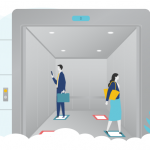Business as Usual? The Employer’s Guide for Returning to Work
June 4, 2020
As Ontario moves into the next phase of coronavirus response, many employers are gearing to reopen their offices and/or move employees back into the workplace. But what does a return to work look like in a post-isolation world and how can employers balance business needs while making public health and safety a top priority?
To help you out, we’ve compiled a list of best practices below to reopen your business in a safe and responsible way and help prevent the spread of COVID-19. This framework is based on guidelines developed by Ontario’s health and safety associations that reflect available scientific evidence and expert opinion.

While this guide highlights many common issues, we recognize that all workplaces are unique and face different challenges. For more detailed information, please consult your sector-specific and jurisdictional safety recommendations or seek legal counsel. Additional guidance will come from federal, provincial, and local governments as more businesses, services, and public spaces are reopened in the coming days and weeks.
Disclaimer: This article is intended for informational purposes only to provide an overview of the potential hazards posed in the workplace due to COVID-19. It is not a substitute for legal or medical advice or any legislated workplace safety regulations. All measures taken to prevent the spread of COVID-19 should be done in compliance with requirements under the Occupational Health and Safety Act and associated Regulations and public health directives issued by the Chief Medical Officer of Health. For a comprehensive risk assessment of your workplace, seek guidance from public health authorities, such as the World Health Organization (WHO), Ontario Ministry of Health, Public Health Ontario and the Centres for Disease Control and Prevention (CDC).
1. Develop a tailored safety response plan.
Employers should adopt a tailored approach to safety precautions, especially if they have multiple locations and/or offices. Consider the following: are your offices located in a public space, urban centre, or a community requiring significant mitigation? What is the function of each location (e.g. head office, satellite office, retail store, manufacturing site, etc.) and how will that affect safety measures? Are you aware of emergency risks in your region and how to prepare for different situations? The local context of each site will determine the risk factor and associated best practices. Before reopening, be sure to:
-
Consult government orders and restrictions to determine whether and when you can legally reopen your physical offices and assess your workplace for any potential infection hazards.
-
Establish an effective Occupational Health and Safety and Infection Prevention and Control Plan (or revise your existing plan). Your plan should follow recommendations from the Ministry of Health and directives from Public Health Ontario and address specific risks based on your office environment. Include detailed policies on operational changes and an action plan in case an employee becomes symptomatic, tests positive or is potentially exposed to COVID-19.
-
Review your business continuity plan for how to maintain key business functions if faced with high absenteeism due to illness among employees or their families and ongoing school closures.
-
Review, revise, and/or relax your sick leave and flexible time off policies to accommodate employees as needed.
-
Carefully select which employees, departments, and groups should return to work based on the nature of your work and when. Recall those with critical functions only, unless they: are of advanced age, suffer from underlying health conditions, are pregnant, or live with individuals in any of the aforementioned categories. Consider cross-training for key individuals to function in multiple positions.
-
If return to work dates are staggered, consider recalling employees in the reverse order of their layoff dates. This way, employees laid off first will also be first to be recalled. Be sure to document the reasoning behind your choices to provide evidence of non-discriminatory selection criteria in the event you are later challenged.
2. Modify business operations to maintain physical distancing.
Physical distancing (at least 2 metres or 6 feet) is required to control the spread of COVID-19 and must be integrated into all facets of business operations. Where feasible, consider the changes below:
-
Keep up teleworking arrangements for all non-essential staff.
-
Continue to postpone non-essential work tasks, activities, and appointments or conduct them virtually using email or teleconferencing (i.e. business travel, conferences, interviews, onboarding, consultations etc.). If in-person meetings are necessary, be sure to follow proper physical distancing, hygiene, and sanitation measures. In some cases, you may even consider holding meetings outdoors.
-
Be mindful of the number of people working in one space and try to limit crowding through: flexible hours, staggered start and break times, job task rotation, and alternating work schedules for different groups of teams of employees.
-
Encourage all employees to practice physical distancing and maintain a distance of 2 metres at all times, even during breaks. Put up signs if needed.
-
Avoid sharing communal office equipment and supplies, like electronic devices, telephones, and workstations.
-
Suspend in-person group gatherings (e.g. potlucks, buffets, team lunches, and other office celebrations) where items may be handled by multiple people. Instead, try to hold these events virtually.
-
Encourage employees to use public transit at non-peak times to use a personal vehicle, if possible, to limit contact with others.
-
Eliminate contact greetings, such as handshakes, hugs, back slaps, and other forms of physical contact which people may engage out of either formality or long standing habit.
3. Implement protocols for managing face-to-face interactions with clients.
For some businesses, direct contact with clients and other third-parties is essential and cannot be avoided. If so, try to limit, or if possible eliminate, the number of face-to-face interactions altogether. Depending on the nature of your work:
-
Consider cashless or contactless pay options, such as online or e-transfer.
-
Modify service delivery (i.e. reduce the number of clients using services at the same time, providing services virtually or outdoors, online ordering, curbside delivery and pickup).
-
Adjust your hours of operation and if necessary, have specific hours of operation for high-risk clients.
-
Encourage proper hand hygiene and sanitation between every interaction and consider supplying employees with personal protective equipment.
-
Notify any relevant third-parties (e.g. clients, business partners, shareholders, suppliers, vendors, delivery companies, regular visitors, etc.) about your COVID-19 management policy. Ask that no person enters your offices for non-essential purposes and explain any containment and safety practices visitors must follow while onsite.
4. Make changes to the workplace to optimize physical distancing.
Incorporate workplace modifications wherever possible to maintain a minimum distance of 2 metres, limit interactions, and ensure compliance with other government-issued guidelines. Employers should:
-
Use floor markings, tables, and other physical barriers to manage traffic flow.
-
Install plexiglass barriers and similar partitions where needed (i.e. reception desk, printers, kitchens, any areas where employees may need to interact with clients, etc.).
-
Reposition workstations or reorganize seating arrangements to avoid close contact (i.e. use every other desk).
-
Consider designating a single employee to operate shared office equipment like printers and copiers and distribute printouts to reduce the risk of spread.
-
Close off or modify certain areas, such as lunchrooms, fitness centres, and time clock stations, to prevent large gatherings. For meeting rooms, post updated “Maximum Occupancy” signage on doors and remove extra chairs to limit meeting attendance while still maintaining distance.
-
Look for opportunities to improve air circulation since increased airflow can reduce contaminant buildup (e.g. open windows, doors, fans, increasing the ventilation system’s air intake). Avoid central recirculation where possible.
-
Consider making certain stairways and/or hallways one way.
-
Reduce the number of building entry points if possible or limit the number of people (employees and/or clients) that can enter a particular work area. If possible, restrict building access to only essential personnel.
-
For shared office spaces, like commercial office buildings, discuss logistics, social distancing, and sanitation measures with landlords for elevators and common building areas, such as stairwells and lobbies.
5. Promote proper workplace sanitation.
Proper sanitation, hand hygiene (for 20 seconds with soap and water), and respiratory etiquette (coughing into your arm or a tissue) are crucial to infection control. To keep workplaces as clean as possible:
-
Consider what supplies will be needed to facilitate a smooth transition to work and pre-order an adequate stock before reopening (e.g. special cleaners, sanitizing wipes, sanitizer, etc.).
-
Deep clean the workplace prior to reopening and set up a schedule to perform daily or weekly intensive cleans moving forward. A deep clean is also recommended if an onsite employee tests positive or presumptively positive for COVID-19.
-
Encourage all employees to keep up with good hand washing and avoid touching their faces. If hand washing is not possible, an alcohol-based hand sanitizer (greater than 60%) can be used. Hand washing should be done as frequently as possible, but especially: before entering the workplace, before and after breaks, after contact with others or surfaces others have touched, and between client interactions.
-
Encourage employees to use a clean tissue or their knuckle or elbow to touch light switches, doors, buttons, etc.
-
Provide access to hand washing stations and place hand sanitizing dispensers in prominent spots throughout occupied work areas. Provide breaks as needed for employees to wash their hands as frequently as possible.
-
Provide additional hygiene supplies, such as disinfectants, soap, paper towels, tissues, sanitizing wipes, and a covered and lined waste container so employees can discard used materials immediately.
-
Sanitize the workplace thoroughly and often, with special attention paid to high-touch touch surfaces, areas, and objects (e.g. phones, computers, keyboards, desks, seating areas, kitchens, washrooms, door handles, railings, service counters, printers, etc.). Follow safe practices when cleaning and use an appropriate cleanser for the job.
-
Put up posters or signage on healthy hygiene practices and/or safety instructions for employees and visitors in public areas.
6. Depending on your business, consider personal protective equipment (PPE).
If your business is in a healthcare setting, or if the above recommendations are not enough when interacting with clients, employers may consider PPE such as gloves, face masks, and eye protection. But keep in mind, PPE is only effective if worn correctly. To combat the risk of contamination:
-
Ensure that training is provided to all staff and includes clear detail on the fit, use, care, putting on and taking off, maintenance, cleaning, and limitations of PPE.
-
Depending on what materials are used, set up practices for proper sanitation and/or disposal and when PPE should be changed.
-
Encourage employees to continue frequent hand washing, even if they are using PPE.
-
If employees are using goggles or face shields, make sure they are assigned to people and not shared, even if they are regularly cleaned.
7. Keep employees informed.
It is vital for all employees in the workplace to understand their role when it comes to health and safety. Employers should:
-
Communicate and provide training on all safety response policies to employees, including operational changes, infection control and sanitation measures, and protocols for employees to follow in various COVID-19 situations, including what to do if they have symptoms. Materials should be easy to understand and available in the appropriate language and literacy level for all workers.
-
Remind workers about policies in place regarding sick leave, paid time off, and teleworking arrangements and communicate any changes or new measures taken to deal with COVID-19.
-
Provide daily or weekly updates to employees on news surrounding COVID-19. Providing accurate and reliable news reduces both the potential for misinformation and slip-ups in safety protocols.
8. Re-evaluate your workplace safety policies on an ongoing basis and revise them accordingly.
The news about COVID-19 changes daily. Employers and employees alike are facing challenges they have never encountered before. Bear in mind that all preventative measures and employment practices will need constant adjustment as we navigate our way through this pandemic. Track your employees. Monitor public health updates. Revisit your policies and make improvements wherever possible. If needed, seek legal advice or consult with health and safety experts on the best practices for your business.
These are trying times. Many businesses are struggling. But we must all do our part to stop the spread of COVID-19. Taking safety measures now won’t just protect your staff and clients—it’ll protect your business in the long-run.
Without preventative policies and controls, businesses face civil liability risk if a client or employee contracts the virus through direct interaction with the business. Plus, under Ontario law, employers have an obligation to protect workers from workplace hazards as set out by the Occupational Health and Safety Act (OSHA). Failure to do so can result in a stop-work order upon inspection by the Ministry of Labour, government fines and penalties, and in serious cases, criminal prosecutions, especially if an employer knowingly allowed employees to work in unsafe conditions.
Safe workplaces must have a plan that clearly outlines and adheres to strict hygiene, sanitation, and physical distancing standards and provides safety training for staff. Until you can implement these safeguards, your business should remain closed.
For more information regarding COVID-19, including other community-based public health guidance, visit the Canada.ca and WHO websites. If you have questions or concerns about your business, your continuity planning, or your business insurance, please connect with us. We are only a call or an email away.
PROLINK’s blog posts are general in nature. They do not take into account your personal objectives or financial situation and are not a substitute for professional advice. The specific terms of your policy will always apply. We bear no responsibility for the accuracy, legality, or timeliness of any external content.




